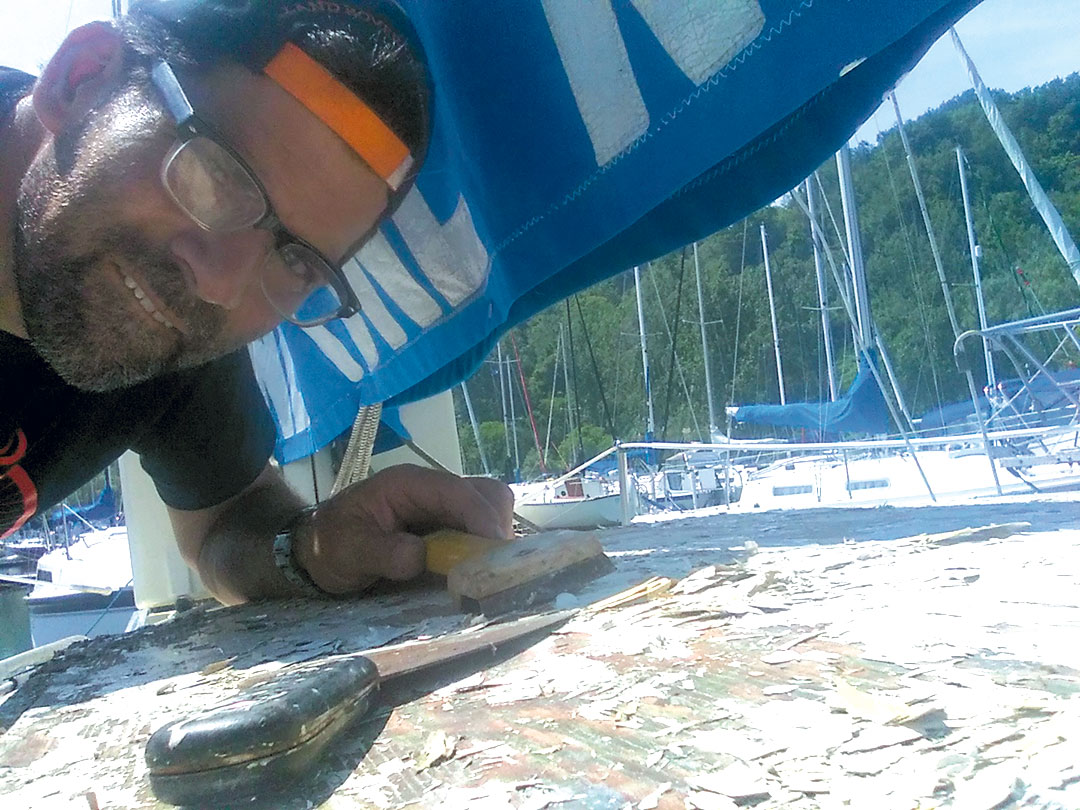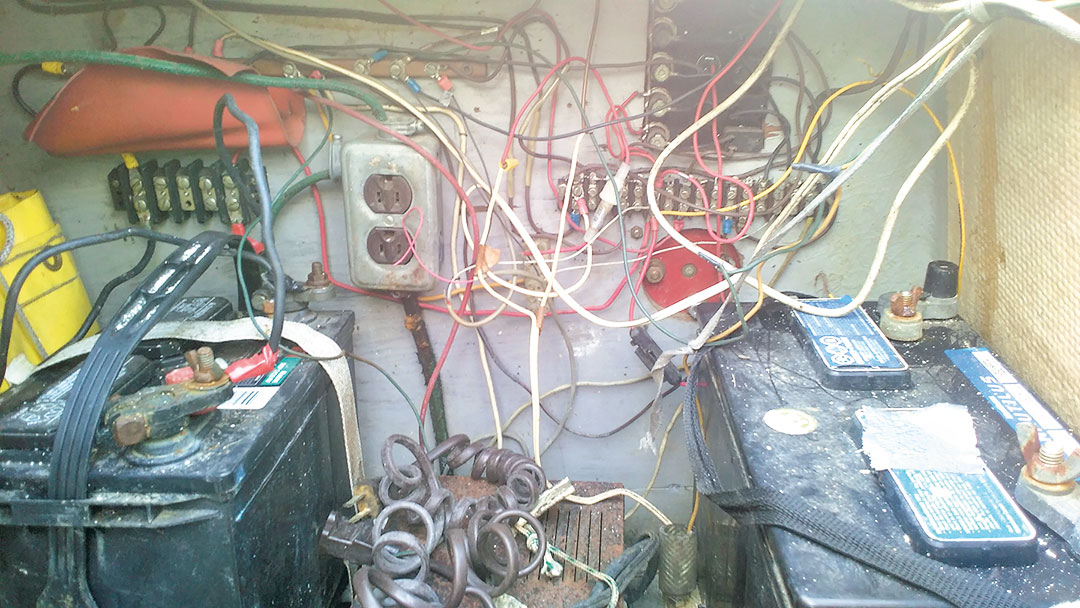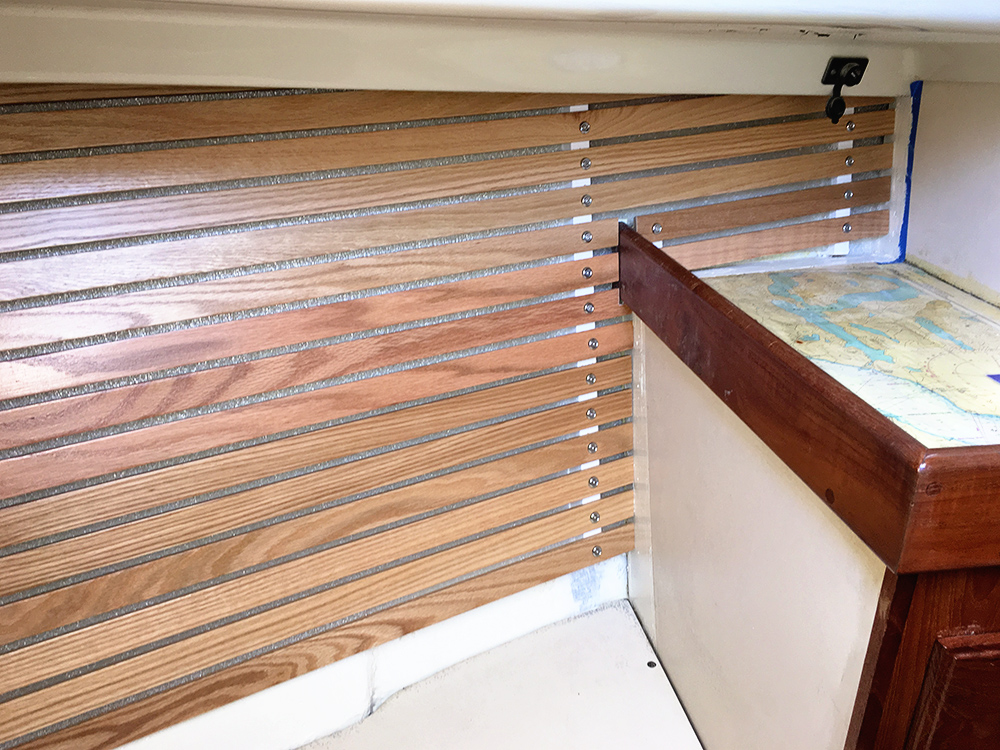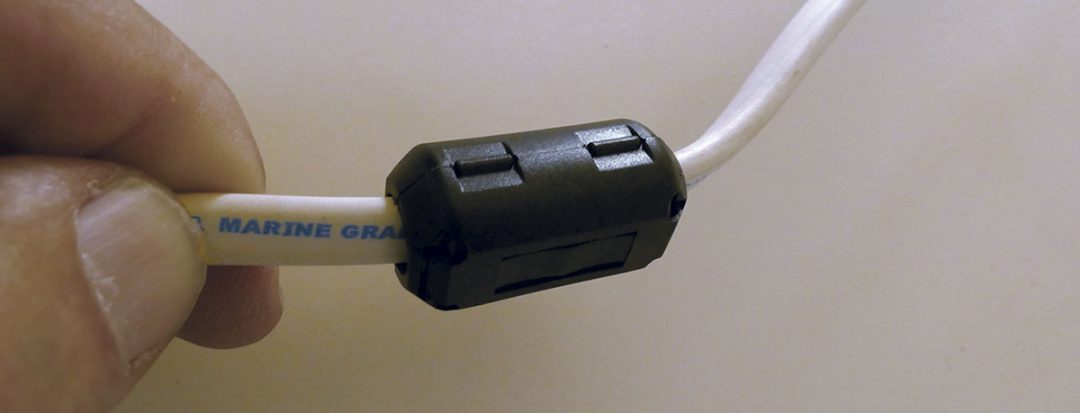Thanks to a little help from her friends, a good old boat finds a new paramour.
Issue 134: Sept/Oct 2020

Nat sits in the cockpit of Mistress, his Hinterhoeller 25, following one of his last sails aboard her.
I didn’t really know Nat. Nothing beyond a friendly smile and hello as we passed each other on the docks. He was in his 90s when he died, but until that time I saw him regularly at the helm of his little blue-hulled sailboat on even the most inhospitable days, chugging out of the harbor and bouncing out into the lake, crashing through white caps. Hardware store letters on the stern spelled Mistress, and I often imagined Nat saying to people in his life, “Well, I’m off to see my mistress.”
Just a few years ago, our Highland Yacht Club on Lake Ontario presented Nat with a special award for saving a life. Nat had invited his son-in-law and grandson for a sail, but the weather was not welcoming. A raging wind and dark skies threatened torrents of rain. No matter, Nat refused to miss this opportunity to take his grandson sailing. So, with several club members watching from the dock, mumbling concern for Nat and his crew aboard his 25-footer, Mistress left the safety of the sheltered harbor and struggled into a turbulent sea, three figures huddled in the cockpit.
A few miles out, they decided they’d had enough. As they came about, the rain started, and Nat’s grandson pointed at what looked like a large log in the water. Fearing it might be a hazard to navigation, Nat eased Mistress’ reefed main to get a closer look. Minutes later, as Mistress rose to the top of a large swell, they made out the head of a person clinging to a paddleboard.
The drowning young man was suffering from hypothermia and couldn’t move his arms or legs. It took all three of the Mistress crew to pull him aboard. Once ashore, he was rushed to the hospital. After making a full recovery, he said he thought he was a goner because no one would be out in that kind of weather.
Two years ago, I volunteered to help launch club boats at the start of the season. I was surprised when told Mistress would need a tow. A tow? Everyone knew that Nat kept his engine in perfect running order—and where was Nat? I pulled Nat’s beloved boat to her dock with a stranger grasping her tiller.
I learned later that Nat had been in the hospital for weeks prior to the launch and that he died the day the rest of us put our boats in the water. As the weeks passed and Nat stories were shared, life at the club went on as we all warmed to the sailing season. Midsummer, our vice commodore approached me to see if I would mentor Cheryl, Nat’s daughter, who had inherited the boat. She had decided to become a member of the club and to keep the boat at its dock. I immediately emailed Cheryl suggesting we get together the following Saturday to look the boat over and see what had to be done.

A younger Nat smiles aboard a younger Mistress after a successful fishing trip.
After not hearing from her or seeing her, I assumed she was an experienced sailor and didn’t need help. Then, two weeks before haulout time, I received an email from Cheryl. She’d been too busy to come down to the boat.
“What is haulout?” she asked. “Do I have to do something about haulout?”
Do something about haulout? Do something about haulout! I told her that at the very least she had to prepare her cradle, prepare the boat, mark the slings, and service the engine. She responded quickly: “OMG.”
Cheryl had last sailed Mistress when she was a teenager. She knew nothing about sailing or owning a boat, but she knew her father loved the boat and so she wanted to keep it, thinking all she had to do was pay her club fees. I could see her heart sink as I explained about work hours, club fees, boat maintenance, and other revelations. Then I did what any sailor would do. I told Cheryl I’d help, and everything would be okay.
Mistress is a Hinterhoeller 25 built in Niagara-on-the-Lake in 1969. I came to learn that Nat hadn’t really been able to take care of her in his later years the way he had decades ago. The wooden hatch had some dry rot, the traveler didn’t travel, the brightwork was all dry and grey, the little outboard engine hadn’t been started or serviced all season, and most of the equipment was original and had seen better days. I also learned that Nat never—never, ever—threw anything away. The lockers were packed with old, mildewed Mae West jackets, a hundred old frayed and stiff lines, original sails, sails from other boats he was going to refit, fishing gear, charts, books, pamphlets, and clothes. I finally told Cheryl that I didn’t know what of all the stuff aboard might mean something to her and so she’d have to clean the boat out.

Larry, proud new owner, stands on the dock near his new Mistress.
Soon after, Cheryl gave me an article she found below, one Nat had written about his 1985 trip down the Intracoastal Waterway (ICW). There was a picture of Nat in the cockpit, young, lithe, confident, and smiling as he headed out for adventure. During his trip, he encountered and overcame problems under power on the Chesapeake and ICW. But on the Atlantic, he hit big weather and his autopilot gave out. After not sleeping for more than 15 minutes uninterrupted for three days, Nat finally pulled into a yacht club in Virginia, hallucinating, dehydrated, and malnourished. He had Mistress shipped back to Lake Ontario where he sailed for the rest of his days.
Over the winter, Cheryl realized that Mistress wasn’t a boat she was ever going to sail and that her father’s attachment to it was the only thing that kept her hanging on to it. Reluctantly, she decided to put it up for sale, “free to a good home.” There were no takers.
Come spring, I received an email from my friend, Larry, whom I’d not seen in a while. He was coming to Toronto and wanted to know if I’d have time to take him out sailing, as we’d done in previous seasons. He’d always loved the experience. I emailed him back: “Why don’t we go sailing on your boat?” That got his attention.
Understanding the importance of setting expectations, I tried to give Larry a better idea of what he was getting himself into: the condition of the boat, the responsibilities of ownership, the expense of refitting her and paying mooring fees at a marina or yacht club. Nothing seemed to deter him; he was all in. The day I was to meet Larry for our sail, he was already at the dock when I arrived.

Larry learning the joys of boat ownership as he works on restoring the companionway cover.
“Is that her?” he said pointing to Mistress.
“That’s her,” I answered, trying to read him.
Larry grinned, “She’s beautiful.”
All that season, Larry worked tirelessly to refit Mistress, always with the help of a willing club member who was either a friend of Nat or who just appreciated seeing an old boat given another life. At one point, our entire parking lot was strewn with sails, lines, tackle, and other paraphernalia taken from the boat and carried ashore. Someone observed that it was like watching the clowns at the circus emerge from a small compact car.
Running rigging was renewed, rotten wood replaced, old hardware repaired, and blocks exchanged. The electrics were a nightmare. Our club marine electronics guru was both perplexed and challenged. He spent one entire day with a multimeter assessing which wires could be torn out and which could still serve. In the end, we all celebrated when we heard the crackle of the VHF radio.

Oddly enough, there was no wiring diagram for Mistress!
And so she was, and with all the power at the bow it was like she was vaulting from one swell to another, romping across the waves feeling a joy she’d been denied those past two years. Larry wanted to stay out and sail longer, but I pointed out that the jib was as old as the main, and if it ripped we might have trouble getting back in as the little outboard would struggle motoring into the headwinds. He agreed and reluctantly brought her about.
Larry’s work took much of his time after that first sail and before we knew it, it was the middle of October, and a decision had to be made. Where would Mistress spend the winter? Larry considered joining our club, but it was a long drive from his home, and there was another club just a five-minute walk for him. The challenge would be moving Mistress from Highland to her new home during the blustery days of October.
After watching the weather carefully for several days, we decided that there wouldn’t be any good days, just some days that were a bit better than others. And so, on a threatening day with cloudy skies, temperatures just above freezing, and a strong wind, Larry and a friend, who was surely wondering what he’d got himself into, motored out of our protected harbor. As he passed us, his Highland support crew, he pointed to the big genoa—not the old working jib—hanked on to the bow. We looked at each other and then we all jumped into a C&C 30, figuring Larry might just need an escort down the lake. We’d all put in too much work on the boat to see it go badly now.

Mistress rests in a slip during the refit under Larry’s care.
Once out past the lighthouse, the white caps were up, and the cold was ripping through our jackets. We could see Mistress further out, struggling. She was sitting head-to-wind with Larry bouncing on the foredeck. As we tacked to sail closer, Larry brought Mistress about and headed back into harbor under the reefed main with the huge head sail flapping. Aboard the C&C, we were concerned. As bad as this weather was, nothing in the forecast was better, and we were running out of time. Haulout was just a few days away. We tried Larry on the radio, but he was too busy handling the boat. We waited on the lake. Soon, Mistress peeked her head out with the old, furled staysail at the bow. Larry wasn’t giving up, he just had to get out of the wind to get that big headsail down. Now we were ready to sail.
With the wind from the southeast, we made good time down the lake under a broad reach. Mistress kept up with us, although she did disappear between swells every now and then. When we reached Toronto harbor, we pulled in for a lunch break. We tied up and then caught Mistress as she motored to the dock. The sun was coming out and it was warming up. Over sandwiches and adult beverages, we talked about the fast sail here, and about the slogging those of us returning on the C&C would have to endure. We all applauded and toasted Larry’s seamanship and Mistress’ seaworthiness. Nat would have been proud.
Later in the week I called Larry. “How are things with the boat?”
“All good. I got the cradle up and finished a few more projects…spending a lot of time down there,” he said. “It’s always fun to announce to my wife in front of her friends that I’m off to see my Mistress. She always wishes me a good time.”
D.B. Davies is a sailor and writer who is a frequent contributor to Good Old Boat. He sails Affinity, his 1974 Grampian 30, around Lake Ontario. After extensively researching the men and sailing schooners of Canada’s Maritime provinces, he wrote a dramatic screenplay about the famous Bluenose and her skipper, Angus Walters. You can find out more at thebluenosemovie.com.
Thank you to Sailrite Enterprises, Inc., for providing free access to back issues of Good Old Boat through intellectual property rights. Sailrite.com





